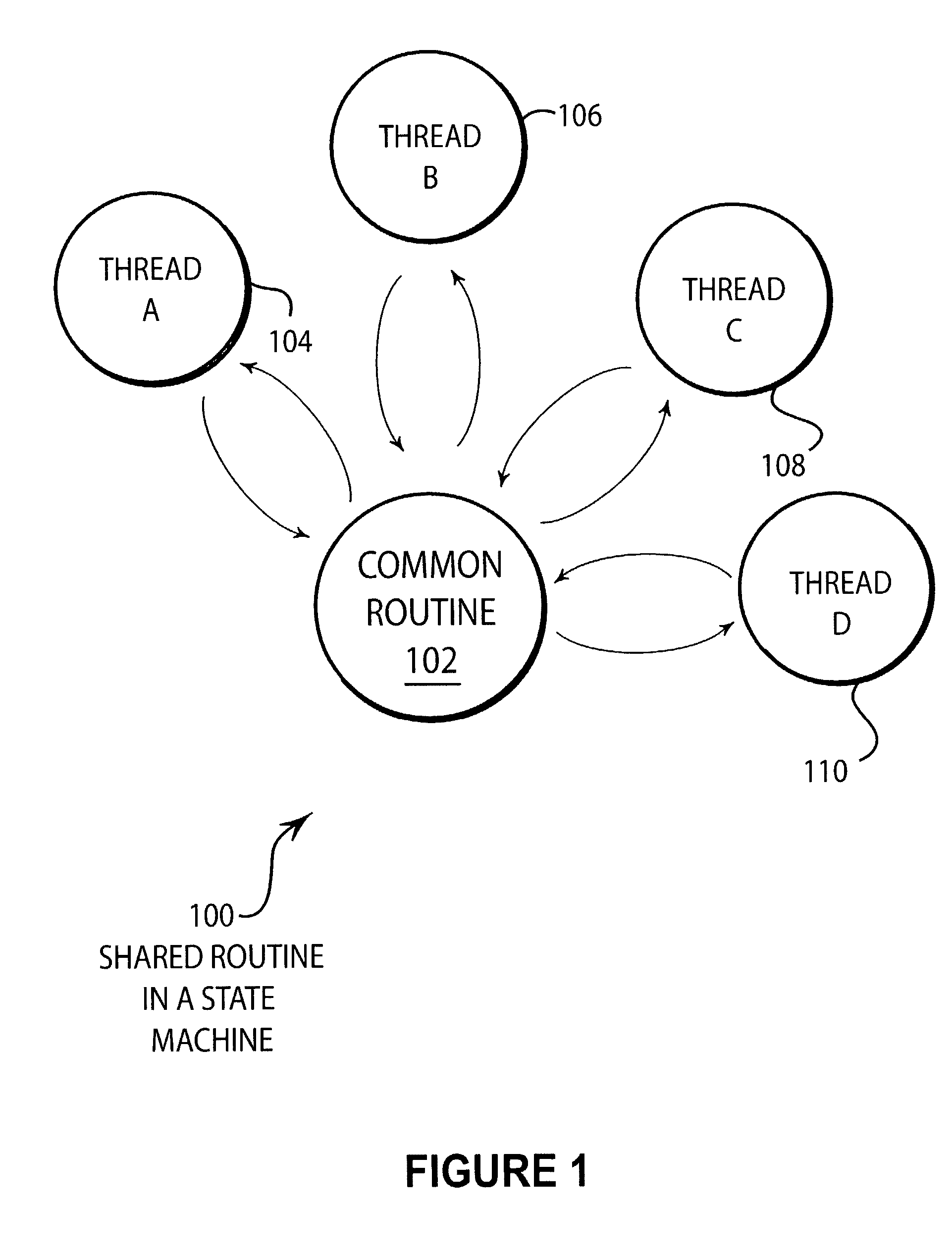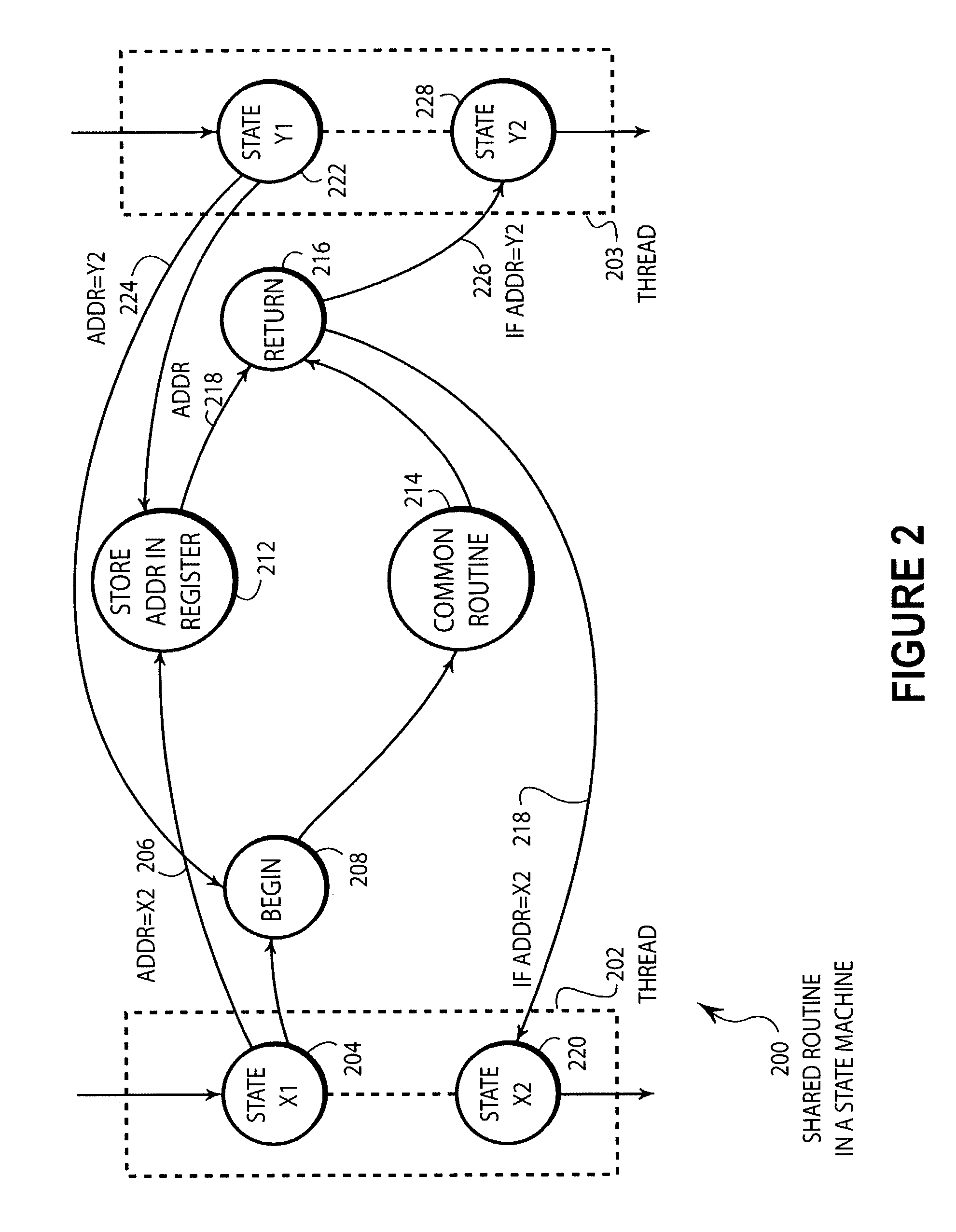Common state sequences in a finite state machine
a finite state machine and common state technology, applied in the field of computation devices, can solve the problems of complex overall implementation and latency in operations, and achieve the effect of reducing latency and overhead, and reducing the number of gates
- Summary
- Abstract
- Description
- Claims
- Application Information
AI Technical Summary
Benefits of technology
Problems solved by technology
Method used
Image
Examples
embodiment 100
[0019]FIG. 1 illustrates an embodiment 100 of the present invention of a shared routine in a state machine. A common routine 102 may be executed by various threads 104, 106, 108, and 110. The routine 102 may be called by each of the threads and have control returned to the thread after the common routine 102 has completed execution.
[0020]The routine 102 may contain a sequence of states that needs to be executed in different threads of the state machine. For example, a state machine that is designed to handle a particular communications protocol may require a handshaking sequence to be executed by different threads. A thread that receives data may require that a series of handshaking lines to toggle in the same manner as a thread that transmits data. Both threads may call a common routine that performs the toggling sequence.
[0021]The control of the individual thread may be passed to the routine 102 and returned to that particular thread when the routine 102 has completed. A return ad...
embodiment 200
[0022]FIG. 2 illustrates an embodiment 200 of the present invention of a shared routine in a state machine. Two different execution threads 202 and 203 each pause execution, transfer execution control to the common routine 214, then pass the execution back to the respective thread. The thread 202 executed until state 204 at which the return address 206 is stored into register 212. The execution thread is passed to the begin state 208 and the set of common steps is executed 214. At the end of the common routine 214, the return function 216 refers to the register 212 to obtain an address 218. The result of the return function 216 is to transfer execution to state 220 based on the address 218.
[0023]The embodiment 200 allows a common routine 214 to be shared by a plurality of threads 202 and 203. A unique identifier for each thread 202 and 203 is stored in the address register 212 prior to executing the common routine 214. When the common routine 214 has completed execution, the value t...
embodiment 300
[0026]FIG. 3 illustrates an embodiment 300 of pseudo-code representation of the present invention of a shared routine in a state machine. A first thread 302 and a second thread 304 each cause a shared routine 306 to be executed. Within the first thread 302, the return address is stored with the continuation state X2 in line 308 and control is passed to the shared routine sub1 in line 310. State X2 is continued in line 312. Similarly, in second thread 304, the return address is stored with the continuation state Y2 in line 314 and control is passed to the shared routine sub1 in line 316. State Y2 is continued in line 318. The shared routine sub1 is begun in line 320. When the shared routine sub1 is completed, the next state is the value stored in the return address in line 322.
[0027]The embodiment 300 may be a series of instructions that is compiled into a series of gates that are created in an integrated circuit. By using a shared routine 306, the overall number of gates in the inte...
PUM
 Login to View More
Login to View More Abstract
Description
Claims
Application Information
 Login to View More
Login to View More - R&D
- Intellectual Property
- Life Sciences
- Materials
- Tech Scout
- Unparalleled Data Quality
- Higher Quality Content
- 60% Fewer Hallucinations
Browse by: Latest US Patents, China's latest patents, Technical Efficacy Thesaurus, Application Domain, Technology Topic, Popular Technical Reports.
© 2025 PatSnap. All rights reserved.Legal|Privacy policy|Modern Slavery Act Transparency Statement|Sitemap|About US| Contact US: help@patsnap.com



